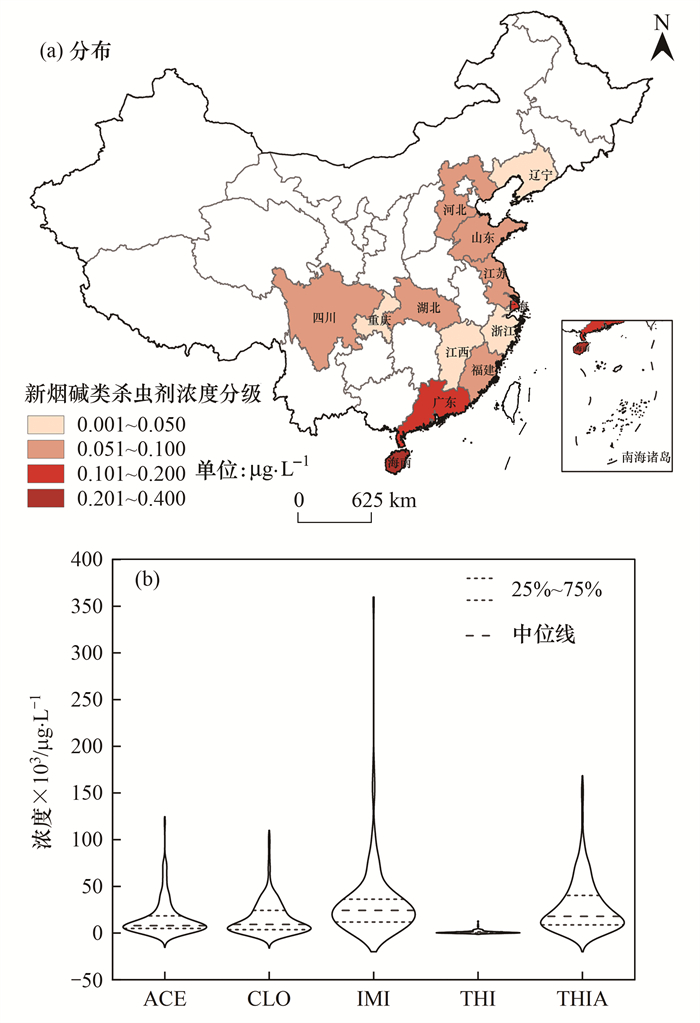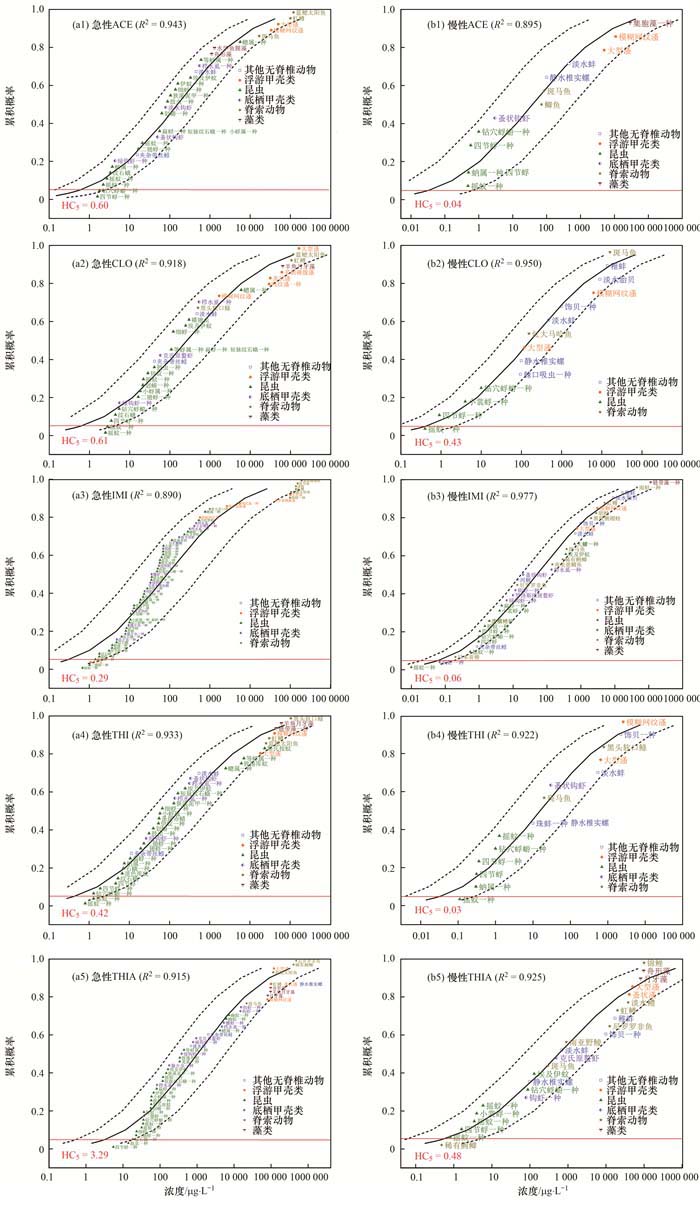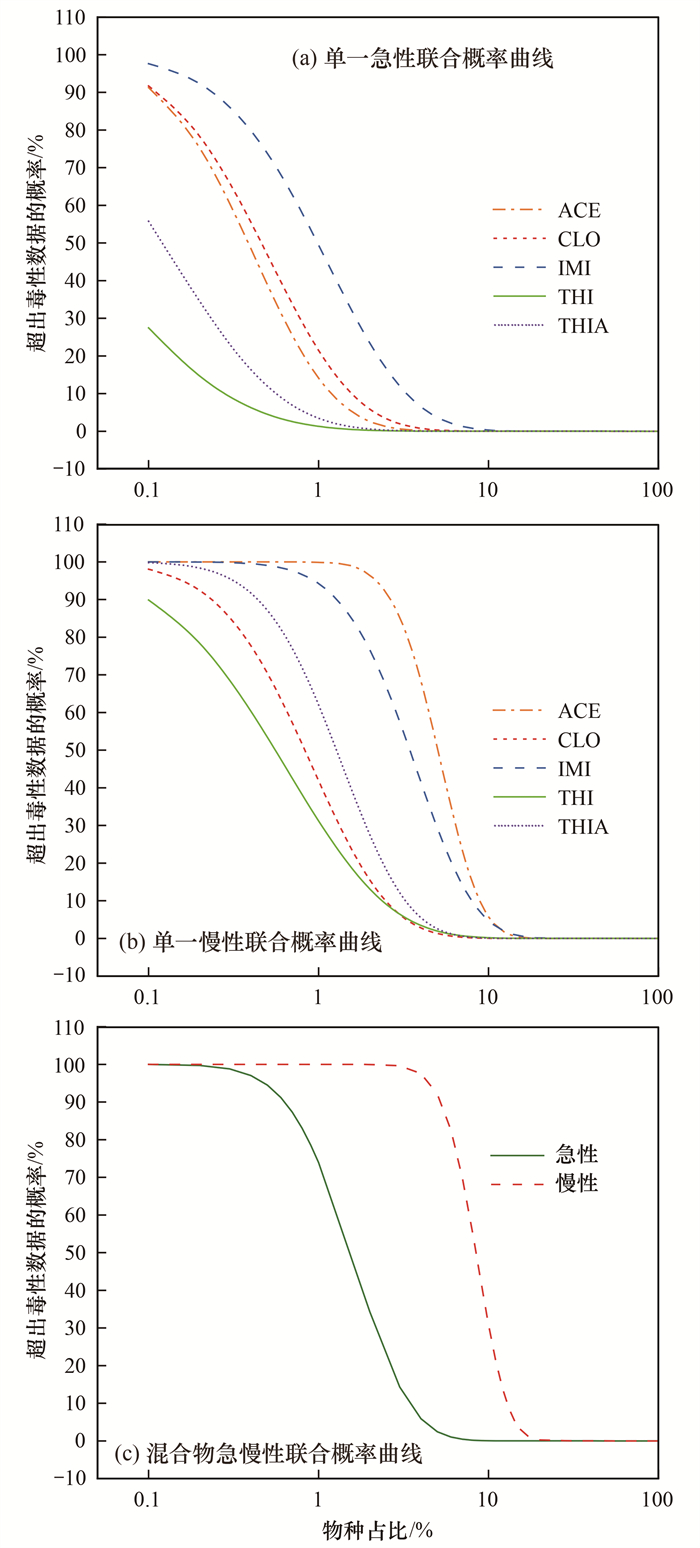中国作为农业大国, 2019年我国的农作物总播种面积高达165 931×103 hm2[1].连年耕作带来的农作物病虫害问题非常凸显, 以致杀虫剂的需求量越来越大, 其中新烟碱类杀虫剂(neonicotinoid insecticides, NNIs)的使用量迅速增长, 截至2014年, NNIs的市场销售额约占全球农药市场总销售额的四分之一[2].中国在NNIs生产、消费和出口方面占世界领先地位, 其中生产量和出口量最大的是吡虫啉, 其年产量和出口量分别为14 000 t和8 000 t[3].
NNIs是一种烟碱型乙酰胆碱受体(nicotinic acetylcholine receptors, nAChRs)的激动剂[4, 5], 会与有害昆虫体内的nAChRs结合, 表现出对昆虫的优先毒性和对脊椎动物的低毒性[4, 6, 7], 从而达到良好的虫害防治效果.目前开展了单一NNI对陆生和哺乳动物危害研究, 如噻虫胺会抑制蜜蜂免疫系统, 降低幼虫和蜂王的存活率[8], 还会对哺乳动物的生殖器官和配子造成不利影响[9].然而, 由于NNIs具有广谱性和极好的水溶性, 可以通过地表径流不断进入到水生态系统中[10], 威胁水体中非靶生物的安全.有广泛检出的吡虫啉、噻虫胺和噻虫嗪的NNIs混合物对蜉蝣若虫复合毒性研究, 发现混合物的联合毒性显著大于单一毒性作用[11].而水环境中的NNIs复合存在是否影响水生态系统的安全以及程度如何还未见报道, 生态风险评价是对环境中污染物产生危害的可能性和程度进行评估.因此开展NNIs单一和联合毒性的水生态的风险研究具有十分重要的现实意义.
本文选择水体中检出率较高、残留浓度较大的5种NNIs啶虫脒(acetamiprid, ACE)、噻虫胺(clothianidin, CLO)、吡虫啉(imidacloprid, IMI)、噻虫啉(thiacloprid, THI)和噻虫嗪(thiamethoxam, THIA)为研究对象, 以中国东中部地区为研究区域, 基于物种敏感度分布法(species sensitivity distribution, SSD), 利用危害商法(hazard quotient, HQ)和概率风险评价法(probabilistic risk assessment, PRA)评估其单一和复合生态风险, 并参考各个国家的水质标准值, 提出保护水生生物安全的NNIs的水质管理目标建议值.
1 材料与方法 1.1 数据获取与筛选NNIs环境暴露数据获取途径为: 以“Neonicotinoid”、“concentration”和“surface water”为关键词, 分别检索web of science (http://apps.webofknowledge.com/)和中国知网(http://www.cnki.net/), 找出明确且同时报道ACE、CLO、IMI、THI和THIA这5种杀虫剂在中国地表水中浓度的研究并进行整理和分析[12~16].截止2021年2月, 整理出187个研究样点的935条数据, 覆盖了13个省行政区, 主要分布于长江水系、珠江水系和东部河口河流, 采样年份在2016~2018年之间.通过加和得到单一采样点5种NNIs的总和, 将采样点按省行政区进行分类并取平均值, 得到每个省行政区中5种NNIs的总环境暴露数据, NNIs单位统一为μg ·L-1.
5种NNIs的急慢性毒性数据来自美国环保署(U. S. EPA)的ECOTOX数据库(http://www.epa.gov/ecotox)和文献[17~20].急性毒性终点包括半数致死浓度(LC50)或半数效应浓度(EC50), 慢性毒性终点采用无观察效应浓度(NOEC)或最低可观察浓度(LOEC)[21~25].毒性数据的筛选依据准确性、相关性和可靠性原则.具体如下: ①1980~2021年2月报道的毒性数据; ②测试地点为实验室, 测试环境为淡水; ③测试NNIs农药纯度≥ 80%; ④对于急性毒性数据, 优先选择暴露时间为鱼类96 h, 无脊椎(溞类)为48 h, 藻类为24 h的测试数据.对于慢性毒性数据, 优先选择暴露时间为鱼类大于14 d, 无脊椎(溞类)21 d, 藻类72 h或96 h的测试数据[17].对同一个物种有多个毒性终点数据可用时, 选择最敏感毒性终点数据; 有多个数据可用于同一物种同一毒性终点时, 取数据的几何平均值[26].将所有毒性数据单位统一为μg ·L-1.
1.2 SSD构建方法将筛选得到的毒性数据按从小到大顺序排列, 按照式(1)计算每个物种的累计概率[27~29]:

|
(1) |
式中, P为累计概率, Ri为物种排序的秩, n为样本数.
1.3 HC5的计算采用Log-Normal分布拟合SSD曲线, 对应95%物种受到保护时的污染物浓度为HC5 (hazard 5% of species concentration)[26, 30~34], 并和最敏感生物的毒性数值进行比较以确定合理的毒性参考值(toxicity reference value, TRV).
1.4 生态风险评价采用危害商法(HQ)和概率风险评价法(PRA)进行生态风险评价.
1.4.1 危害商法危害商法通过计算自然水体中污染物暴露浓度与其毒性参考值(TRVi)的比值, 判断该污染物在环境中的危害, 可以判断污染物风险.若HQ>1, 则环境风险较高; 若HQ < 1, 则环境风险较低[35].单一杀虫剂HQ值的计算见式(2).

|
(2) |
式中, MECi为杀虫剂i的环境浓度; TRVi杀虫剂i的毒性参考值, 一般采用HC5值, 若HC5值无法保护所有已知生物, 则采用PNEC (predicted no effect concentration)值, 具体计算见式(3)[26, 36~38]:

|
(3) |
式中, AF为评估因子, 取2~5[26].以不同杀虫剂最敏感水生生物的毒性数据为参考, 确定CLO和THIA的评估因子为2, IMI的评估因子为5, 以保证PNEC值能保护所有已知生物.
根据本文收集的实际环境暴露浓度, 可计算各行政地区中5种NNIs暴露浓度的最大值、中值和均值.选取最大暴露浓度和TRVi acute值, 利用公式(2)得到急性HQ值; 选取中值暴露浓度和TRVi chronic值, 得到慢性HQ值, 若行政地区中可用浓度数量≤ 2, 则选用均值暴露浓度计算.
1.4.2 概率风险评价利用收集到的环境暴露数据, 得到5种NNIs的环境暴露浓度分布(ECD), 结合对应SSD曲线绘制出联合概率曲线(JPC), 计算水环境暴露浓度大于效应浓度的概率来判断风险的大小[35, 39, 40].曲线越靠近横纵坐标轴, 表明该杀虫剂发生不利影响的可能性越小[35].
参照毒性当量的概念和原理, 以发生最大不利影响的杀虫剂为参照物, 将其余农药的环境暴露浓度利用公式(4)转化为该农药的当量浓度, 研究混合污染物的复合风险[41]:

|
(4) |
式中, ci为第i种污染物的环境暴露浓度, HC50, ref和HC50, i分别为水生生物50%受到参照化合物和第i种化合物危害的浓度.
2 结果与讨论 2.1 淡水环境NNIs污染现状本文研究涉及省行政区的水环境NNIs污染现状和研究区域内各NNIs浓度分布区间如图 1所示.

|
ACE: 啶虫脒; CLO: 噻虫胺; IMI: 吡虫啉; THI: 噻虫啉; THIA: 噻虫嗪 图 1 我国地表水新烟碱类杀虫剂浓度分布和浓度范围 Fig. 1 Concentration distribution and range of NNIs in surface water |
由图 1(a)可知, 5种NNIs的总环境暴露浓度存在一定的空间分布差异性, 其反映的水环境污染程度可分为4个等级.其中, 水环境暴露浓度最高的省份为海南省(0.35 μg ·L-1), 其次是上海市(0.15 μg ·L-1)和广东省(0.11 μg ·L-1), 四川省(0.08 μg ·L-1)、湖北省(0.08 μg ·L-1)、江苏省(0.08 μg ·L-1)、河北省(0.07 μg ·L-1)、山东省(0.07 μg ·L-1)和福建省(0.06 μg ·L-1)位于第三等级, 而后第四等级是浙江省(0.04 μg ·L-1)、重庆市(0.03 μg ·L-1)、辽宁省(0.02 μg ·L-1)和江西省(0.02 μg ·L-1).
海南省、上海市和广东省地表水中NNIs浓度均超过了0.10 μg ·L-1, 海南省全年的气温较高, 雨量充沛, 且多种植热带果树, 为病虫害的高发区, 因此海南省常常使用各种杀虫剂对果园进行喷洒以保证果树正常生长.其中IMI属于高温农药, 其杀虫效果和温度呈正相关, 且适用于绝大多数种植果树, 包括热带果树[42], 故海南省的杀虫剂更多依赖于IMI, 因此, 地表水中NNIs浓度也相对较高; 广东省的农业种植面积较大(4 357.4×103 hm2), 且NNIs的使用率较高; 而上海市则是因为区域内流域面积较小, 使得地表水中NNIs浓度较高[15].
由图 1(b)可知, 研究区域中NNIs以IMI为主, 其次是THIA、ACE和CLO, 最少的是杀虫剂THI.根据中国农药信息网可知, 有效成分为IMI的农药可使用于61种农作物, 有效成分为THIA、ACE和CLO的农药可分别使用于49、31和25种农作物, 有效成分为THI的农药仅可作用于17种农作物.这些农作物在研究区域内均有种植, 间接解释研究区域地表水NNIs杀虫剂残留浓度结构的变化.
2.2 SSD曲线绘制在SSD Generator中采用Log-Normal对收集到的毒性数据进行曲线拟合, 得到5种NNIs的急慢性SSD曲线(图 2).

|
图 2 5种新烟碱类杀虫剂的急性和慢性物种敏感度分布曲线 Fig. 2 Acute and chronic species sensitivity distributions of five neonicotinoids |
由图 2(a)可知, 5种NNIs的急性HC5值从小到大依次为: IMI < THI < ACE < CLO < THIA.此外, 从图 2(a)中可以看出SSD曲线的左下方主要是昆虫, 即昆虫对5种新烟碱类农药最敏感, 因此政府应严格控制5种NNIs的短期暴露最大浓度, 以最大程度保护杀虫剂喷洒期对非目标昆虫的安全.
由图 2(b)可知, 5种NNIs的慢性HC5值从小到大依次为: THI < ACE < IMI < CLO < THIA.其中, 杀虫剂CLO、IMI和THIA均有物种的毒性数据小于对应的慢性HC5值, 即通过慢性SSD曲线拟合得到的慢性HC5值无法保护所有已知毒性数据的淡水生物, 需要选择合适的评估因子以得到可以保护所有已知淡水生物的毒性参考值. SSD曲线的左下方绝大多数是昆虫, 部分是底栖甲壳类和脊索动物, 表明在慢性危害评估中, 昆虫对5种NNIs十分敏感, 部分底栖甲壳类和脊索动物对杀虫剂IMI也较为敏感, 因此, 应加强对5种NNIs长期暴露浓度的管控工作, 以最大程度保护昆虫、底栖甲壳类动物和脊索动物的安全.
2.3 风险评价结果 2.3.1 危害商法评价以SSD曲线得到的HC5值为毒性参考值(TRVi)对5种NNIs进行急性和慢性危害评估, 其中CLO、IMI和THIA的慢性HC5值无法保护目前已知的所有生物, 因此分别选取2或5作为3种NNIs的慢性评估因子(AF), 根据式(3), 计算PNEC值以替代慢性毒性参考值(TRVi chronic), 最终5种NNIs的急性毒性参考值(TRVi acute)从小到大依次为: IMI (0.29 μg ·L-1)、THI (0.42 μg ·L-1)、ACE (0.60 μg ·L-1)、CLO (0.61 μg ·L-1)和THIA (3.29 μg ·L-1); TRVi chronic值从小到大依次为: IMI (0.01 μg ·L-1)、THI (0.03 μg ·L-1)、ACE (0.04 μg ·L-1)、CLO (0.22 μg ·L-1)和THIA (0.24 μg ·L-1).杀虫剂IMI的急慢性生态危害最大.
由表 1可知, 仅杀虫剂IMI的急性HQ值(1.224)大于1, 存在较高的生物危害.在急性危害评估中, 危害最大的杀虫剂为IMI, 危害最高的地区为海南省.由急性SSD曲线可知, 昆虫对杀虫剂IMI最敏感, 特别是摇蚊幼虫(Chironomus dilutes).此外, 杀虫剂IMI在11个行政地区的慢性HQ值和杀虫剂ACE在2个行政地区的慢性HQ值均大于1, 都存在较高的环境危害.因此, 在慢性危害评估中, 危害最大的杀虫剂为IMI, 其次是ACE.其中, 杀虫剂IMI在海南省的危害最高(HQ=21.628), 其余高危害地区随HQ值从大到小依次为: 上海市(7.890)、山东省(3.658)、江苏省(3.090)、广东省(2.790)、福建省(2.304)、河北省(2.026)、湖北省(1.710)、重庆市(1.635)、四川省(1.203)和浙江省(1.182).杀虫剂ACE危害最高的地区也是海南省(HQ=1.533), 其次是上海市(HQ=1.148).由慢性SSD曲线可知, 昆虫、底栖甲壳动物和脊索动物对IMI均较为敏感, 特别是摇蚊幼虫(Chironomus dilutes); 同样, 对杀虫剂ACE最为敏感的生物类群也是昆虫, 特别是摇蚊(Chironomus dilutes).因此为保护海南省和上海市两地大多数昆虫, 关注IMI的同时也要关注ACE的污染, 避免生态环境恶化.
|
|
表 1 急性和慢性危害评估中风险商(HQ)预测值 Table 1 Predicted HQ values of neonicotinoids in acute and chronic risk assessment |
2.3.2 联合概率风险评价
根据5种NNIs的ECDs和急慢性SSD曲线分别绘制急慢性联合概率分布曲线, 同时以杀虫剂IMI和ACE作为混合物急性JPC曲线和慢性JPC曲线的参照物, 利用公式(4)将其余杀虫剂的实际浓度转化为这两种杀虫剂的当量浓度, 结合IMI的急性SSD曲线和ACE的慢性SSD曲线, 分析得到混合物的急慢性JPCs曲线(图 3).

|
图 3 不同省份地表水中5种新烟碱类杀虫剂的单一急慢性联合概率曲线和混合物急慢性联合概率曲线 Fig. 3 Single acute and chronic joint probability curves and mixture joint probability curves of five neonicotinoids in surface water of different provinces |
由图 3(a)可知, 5种NNIs的急性JPCs曲线均靠近坐标轴, 故其发生不利影响的可能性均较小.不利影响发生可能性最大的杀虫剂为IMI.由图 3(b)可知, 杀虫剂CLO、THI和THIA的慢性JPCs曲线离坐标轴的距离较近, 而ACE的慢性JPCs曲线与坐标轴距离要大于IMI, 且远大于其余3种杀虫剂, ACE是发生不利影响可能性最大的NNIs杀虫剂.
由图 3(c)可知, 混合物的急性JPC曲线与坐标轴的距离要远小于慢性JPC曲线与坐标轴之间的距离, 表明当水生生物持续暴露在5种NNIs混合物中时, 其受混合物影响发生不利反应的可能性较大.此外, 由混合物急性JPC曲线得到的5%生物受影响的概率较低(2.44%), 与单一杀虫剂IMI得到的影响概率相似(3.68%), 而由混合物慢性JPC曲线得到的5%生物受影响概率高达92.12%, 高于单一杀虫剂ACE得到的影响概率(50.61%), 远高于其余杀虫剂得到的影响概率(IMI=29.32%, THIA=2.56%, THI=1.95%, CLO=1.29%), 即5种NNIs的急性混合生态风险较小, 而慢性生态毒性具有极强的联合作用, 混合物的慢性生态风险不可忽视.
基于SSD曲线提出保护水生生物安全的急慢性目标值(表 2), 与其他国家的标准值存在一定差异, 这是因为我国和其他国家的地理环境不同且敏感种存在差异.啶虫脒和噻虫啉的慢性HC5值可以保护目前已知的所有水生生物, 因此建议保护水生生物长期安全的我国地表水质监管目标值分别为啶虫脒0.04 μg ·L-1和噻虫啉0.03 μg ·L-1.噻虫胺、吡虫啉和噻虫嗪的慢性HC5值无法保护目前已知的所有水生生物, 故分别选取2或5作为3种NNIs的慢性评估因子(AF), 根据式(3)得到PNEC值, 最终建议保护水生生物长期安全的我国地表水质监管目标值分别为噻虫胺0.22 μg ·L-1、吡虫啉0.01 μg ·L-1和噻虫嗪0.24 μg ·L-1.这不仅为5种NNIs提供了新的水质基准参考值, 也为我国水质标准制定提供了根据, 具有巨大的现实意义.
|
|
表 2 不同地区和国家的5种新烟碱类杀虫剂水质标准1)/μg ·L-1 Table 2 Water quality standards of five neonicotinoid insecticides in different countries/μg ·L-1 |
3 结论
(1) 危害评估中, 吡虫啉和啶虫脒对淡水生态系统生物发生慢性危害较大, 危害最大的生物类型为摇蚊幼虫(Chironomus dilutes); 海南省是急慢性危害最高的地区.
(2) 5种NNIs的急性混合生态风险较小, 而慢性混合生态毒性具有极强的联合作用, 生态风险较大, 5%生物受影响概率高达92.12%, 严重影响绝大多数生物的安全.
(3) 要加强管控危害大的吡虫啉和啶虫脒, 且要关注其余NNIs的暴露浓度, 避免发生联合作用造成更大的生态风险.建议保护水生生物安全的中国地表水质监管目标值分别为啶虫脒0.04 μg ·L-1、噻虫胺0.22 μg ·L-1、吡虫啉0.01 μg ·L-1、噻虫啉0.03 μg ·L-1和噻虫嗪0.24 μg ·L-1.
| [1] | 国家统计局. 中国统计年鉴2020[EB/OL]. http://www.stats.gov.cn/tjsj/ndsj/2020/indexch.htm, 2021-08-19. |
| [2] | Bass C, Denholm I, Williamson M S, et al. The global status of insect resistance to neonicotinoid insecticides[J]. Pesticide Biochemistry and Physiology, 2015, 121: 78-87. DOI:10.1016/j.pestbp.2015.04.004 |
| [3] | Shao X S, Liu Z W, Xu X Y, et al. Overall status of neonicotinoid insecticides in China: production, application and innovation[J]. Journal of Pesticide Science, 2013, 38(1): 1-9. DOI:10.1584/jpestics.D12-037 |
| [4] | Goulson D. REVIEW: an overview of the environmental risks posed by neonicotinoid insecticides[J]. Journal of Applied Ecology, 2013, 50(4): 977-987. DOI:10.1111/1365-2664.12111 |
| [5] | Jeschke P, Nauen R, Beck M E. Nicotinic acetylcholine receptor agonists: a milestone for modern crop protection[J]. Angewandte Chemie International Edition, 2013, 52(36): 9464-9485. DOI:10.1002/anie.201302550 |
| [6] | Jeschke P, Nauen R, Schindler M, et al. Overview of the status and global strategy for neonicotinoids[J]. Journal of Agricultural and Food Chemistry, 2011, 59(7): 2897-2908. DOI:10.1021/jf101303g |
| [7] | Simon-Delso N, Amaral-Rogers V, Belzunces L P, et al. Systemic insecticides (neonicotinoids and fipronil): trends, uses, mode of action and metabolites[J]. Environmental Science and Pollution Research, 2015, 22(1): 5-34. DOI:10.1007/s11356-014-3470-y |
| [8] | Di Prisco G, Cavaliere V, Annoscia D, et al. Neonicotinoid clothianidin adversely affects insect immunity and promotes replication of a viral pathogen in honey bees[J]. Proceedings of the National Academy of Sciences of the United States of America, 2013, 110(46): 18466-18471. DOI:10.1073/pnas.1314923110 |
| [9] | Bal R, Türk G, YƖlmaz Ö, et al. Effects of clothianidin exposure on sperm quality, testicular apoptosis and fatty acid composition in developing male rats[J]. Cell Biology and Toxicology, 2012, 28(3): 187-200. DOI:10.1007/s10565-012-9215-0 |
| [10] | De Perre C, Murphy T M, Lydy M J. Fate and effects of clothianidin in fields using conservation practices[J]. Environmental Toxicology and Chemistry, 2015, 34(2): 258-265. DOI:10.1002/etc.2800 |
| [11] | Macaulay S J, Hageman K J, Piggott J J, et al. Imidacloprid dominates the combined toxicities of neonicotinoid mixtures to stream mayfly nymphs[J]. Science of the Total Environment, 2021, 761. DOI:10.1016/j.scitotenv.2020.143263 |
| [12] | Yi X H, Zhang C, Liu H B, et al. Occurrence and distribution of neonicotinoid insecticides in surface water and sediment of the Guangzhou section of the Pearl River, South China[J]. Environmental Pollution, 2019, 251: 892-900. DOI:10.1016/j.envpol.2019.05.062 |
| [13] | Zhang C, Tian D, Yi X H, et al. Occurrence, distribution and seasonal variation of five neonicotinoid insecticides in surface water and sediment of the Pearl Rivers, South China[J]. Chemosphere, 2019, 217: 437-446. DOI:10.1016/j.chemosphere.2018.11.024 |
| [14] | Chen Y C, Zang L, Liu M D, et al. Ecological risk assessment of the increasing use of the neonicotinoid insecticides along the east coast of China[J]. Environment International, 2019, 127: 550-557. DOI:10.1016/j.envint.2019.04.010 |
| [15] | Chen Y C, Zang L, Shen G F, et al. Resolution of the ongoing challenge of estimating nonpoint source neonicotinoid pollution in the Yangtze River basin using a modified mass balance approach[J]. Environmental Science & Technology, 2019, 53(5): 2539-2548. |
| [16] | Wan Y J, Wang Y, Xia W, et al. Neonicotinoids in raw, finished, and tap water from Wuhan, Central China: assessment of human exposure potential[J]. Science of the Total Environment, 2019, 675: 513-519. DOI:10.1016/j.scitotenv.2019.04.267 |
| [17] | Morrissey C A, Mineau P, Devries J H, et al. Neonicotinoid contamination of global surface waters and associated risk to aquatic invertebrates: a review[J]. Environment International, 2015, 74: 291-303. DOI:10.1016/j.envint.2014.10.024 |
| [18] | Raby M, Nowierski M, Perlov D, et al. Acute toxicity of 6 neonicotinoid insecticides to freshwater invertebrates[J]. Environmental Toxicology and Chemistry, 2018, 37(5): 1430-1445. DOI:10.1002/etc.4088 |
| [19] | Hook S E, Doan H, Gonzago D, et al. The impacts of modern-use pesticides on shrimp aquaculture: an assessment for north eastern Australia[J]. Ecotoxicology and Environmental Safety, 2018, 148: 770-780. DOI:10.1016/j.ecoenv.2017.11.028 |
| [20] | Finnegan M C, Baxter L R, Maul J D, et al. Comprehensive characterization of the acute and chronic toxicity of the neonicotinoid insecticide thiamethoxam to a suite of aquatic primary producers, invertebrates, and fish[J]. Environmental Toxicology and Chemistry, 2017, 36(10): 2838-2848. DOI:10.1002/etc.3846 |
| [21] | 孟伟, 吴丰昌. 水质基准的理论与方法学导论[M]. 北京: 科学出版社, 2010. |
| [22] |
李会仙, 吴丰昌, 陈艳卿, 等. 我国水质标准与国外水质标准/基准的对比分析[J]. 中国给水排水, 2012, 28(8): 15-18. Li H X, Wu F C, Chen Y Q, et al. Comparative analysis on Chinese water quality standards and foreign water quality standards/criteria[J]. China Water & Wastewater, 2012, 28(8): 15-18. DOI:10.3969/j.issn.1000-4602.2012.08.004 |
| [23] |
冯承莲, 吴丰昌, 赵晓丽, 等. 水质基准研究与进展[J]. 中国科学: 地球科学, 2012, 55(5): 646-656. Feng C L, Wu F C, Zhao X L, et al. Water quality criteria research and progress[J]. Science China Earth Science, 2012, 55(6): 882-891. |
| [24] | Wu F C, Meng W, Zhao X L, et al. China embarking on development of its own national water quality criteria system[J]. Environmental Science & Technology, 2010, 44(21): 7992-7993. |
| [25] | Jin X W, Wang Y Y, Giesy J P, et al. Development of aquatic life criteria in China: viewpoint on the challenge[J]. Environmental Science and Pollution Research, 2014, 21(1): 61-66. DOI:10.1007/s11356-013-1667-0 |
| [26] | Stephan C E, Mount D I, Hansen D J, et al. Guidelines for deriving numerical national water quality criteria for the protection of aquatic organisms and their uses[R]. Washington DC: United States Environmental Protection Agency, 1985. |
| [27] |
陈心悦, 张彦峰, 沈兆爽, 等. 中国七大水系淡水沉积物中林丹(γ-HCH)的生态风险评估[J]. 生态毒理学报, 2018, 13(3): 103-111. Chen X Y, Zhang Y F, Shen Z S, et al. Ecological risk assessment of γ-HCH for freshwater sediment of seven major river systems in China[J]. Asian Journal of Ecotoxicology, 2018, 13(3): 103-111. |
| [28] |
刘建梅, 王蕾, 刘济宁, 等. 微宇宙技术和物种敏感度分布曲线法评估铜离子生态危害比对研究[J]. 生态毒理学报, 2015, 10(4): 34-46. Liu J M, Wang L, Liu J N, et al. A microcosm study compared to the species sensitivity distribution approach: a case study with the copper ion[J]. Asian Journal of Ecotoxicology, 2015, 10(4): 34-46. |
| [29] |
孙雪华, 孙成, 刘红玲. 考虑物种权重校验保护太湖水生生物的铅基准[J]. 环境化学, 2020, 39(6): 1578-1589. Sun X H, Sun C, Liu H L. Weighted species sensitivity distribution method to derive site-specific quality criteria of lead for protection of aquatic life in Tai Lake[J]. Environmental Chemistry, 2020, 39(6): 1578-1589. |
| [30] | Wang B, Yu G, Huang J, et al. Development of species sensitivity distributions and estimation of HC5 of organochlorine pesticides with five statistical approaches[J]. Ecotoxicology, 2008, 17(8): 716-724. DOI:10.1007/s10646-008-0220-2 |
| [31] |
王印, 王军军, 秦宁, 等. 应用物种敏感性分布评估DDT和林丹对淡水生物的生态风险[J]. 环境科学学报, 2009, 29(11): 2407-2414. Wang Y, Wang J J, Qin N, et al. Assessing ecological risks of DDT and lindane to freshwater organisms by species sensitivity distributions[J]. Acta Scientiae Circumstantiae, 2009, 29(11): 2407-2414. DOI:10.3321/j.issn:1672-2043.2009.11.035 |
| [32] |
杜建国, 赵佳懿, 陈彬, 等. 应用物种敏感性分布评估中国近海和福建主要海湾水体重金属生态风险[J]. 生态毒理学报, 2013, 8(4): 554-560. Du J G, Zhao J Y, Chen B, et al. Assessing ecological risks of heavy metals to marine organisms in Chinese offshore and Fujian's main bays by species sensitivity distributions[J]. Asian Journal of Ecotoxicology, 2013, 8(4): 554-560. |
| [33] |
陈锦灿, 方超, 郑榕辉, 等. 应用物种敏感性分布评估微(纳米)塑料对水生生物的生态风险[J]. 生态毒理学报, 2020, 15(1): 242-255. Chen J C, Fang C, Zheng R H, et al. Assessing ecological risks of micro (nano) plastics to aquatic organisms using species sensitivity distributions[J]. Asian Journal of Ecotoxicology, 2020, 15(1): 242-255. |
| [34] |
赵芊渊, 侯俊, 王超, 等. 应用概率物种敏感度分布法研究太湖重金属水生生物水质基准[J]. 生态毒理学报, 2015, 10(6): 121-128. Zhao Q Y, Hou J, Wang C, et al. Deriving aquatic water quality criteria for heavy metals in Taihu Lake by probabilistic species sensitivity distribution[J]. Asian Journal of Ecotoxicology, 2015, 10(6): 121-128. |
| [35] | Solomon K, Giesy J, Jones P. Probabilistic risk assessment of agrochemicals in the environment[J]. Crop Protection, 2000, 19(8-10): 649-655. DOI:10.1016/S0261-2194(00)00086-7 |
| [36] |
孙甜甜, 田永静, 赵炜, 等. 太湖流域苏州城区不同用地类型降雨径流中重金属的生态风险评价[J]. 湖泊科学, 2020, 32(6): 1620-1631. Sun T T, Tian Y J, Zhao W, et al. Ecological risk assessment of heavy metals in rainfall runoff of different land use types in Suzhou of Taihu basin[J]. Journal of Lake Sciences, 2020, 32(6): 1620-1631. |
| [37] |
孙乾航, 郑欣, 闫振广, 等. 淡水环境中短链氯化石蜡的预测无效应浓度及生态风险评估[J]. 生态毒理学报, 2020, 15(1): 256-264. Sun Q H, Zheng X, Yan Z G, et al. Predicted no effect concentration and ecological risk assessment of SCCPs in freshwater environments[J]. Asian Journal of Ecotoxicology, 2020, 15(1): 256-264. |
| [38] |
张家玮, 齐观景, 赵昊铎, 等. 基于物种敏感性分布评价长三角地区地表水壬基酚生态风险[J]. 生态毒理学报, 2020, 15(3): 134-148. Zhang J W, Qi G J, Zhao H D, et al. Ecological risk assessment of nonylphenol in surface waters of the Yangtze River delta based on species sensitivity distribution model[J]. Asian Journal of Ecotoxicology, 2020, 15(3): 134-148. |
| [39] | Hela D G, Lambropoulou D A, Konstantinou I K, et al. Environmental monitoring and ecological risk assessment for pesticide contamination and effects in Lake Pamvotis, northwestern Greece[J]. Environmental Toxicology and Chemistry, 2005, 24(6): 1548-1556. DOI:10.1897/04-455R.1 |
| [40] | Zolezzi M, Cattaneo C, Tarazona J V. Probabilistic ecological risk assessment of 1, 2, 4-trichlorobenzene at a former industrial contaminated site[J]. Environmental Science & Technology, 2005, 39(9): 2920-2926. |
| [41] |
刘帆, 孔昊玥, 刘红玲. 基于权重敏感度分布研究太湖有机磷农药单一和复合风险[J]. 生态毒理学报, 2020, 15(2): 130-140. Liu F, Kong H Y, Liu H L. Study on risk of organophosphate pesticides mixture in Tai Lake based on weight species sensitivity distribution[J]. Asian Journal of Ecotoxicology, 2020, 15(2): 130-140. |
| [42] | 中华人民共和国农业农村部农药检定所. 中国农药信息网[EB/OL]. http://www.chinapesticide.org.cn/yxcftozw.jhtml, 2021-08-19. |
| [43] | Stehle S, Schulz R. Agricultural insecticides threaten surface waters at the global scale[J]. Proceedings of the National Academy of Sciences of the United States of America, 2015, 112(18): 5750-5755. DOI:10.1073/pnas.1500232112 |
| [44] | Smit C E, Posthuma-Doodeman C J A M, Van Vlaardingen P L A, et al. Ecotoxicity of imidacloprid to aquatic organisms: derivation of water quality standards for peak and long-term exposure[J]. Human and Ecological Risk Assessment: An International Journal, 2015, 21(6): 1608-1630. DOI:10.1080/10807039.2014.964071 |
| [45] | European Union. Directive 98/8/EC concerning the placing of biocidal products on the market Inclusion of active substances in annex I to directive 98/8/EC assessment report clothianidin product-type 8 (wood preservative)[R]. Europe: European Union, 2007. |
| [46] | Netherlands National Institute for Public Health and the Environment. Search system risks of substances[EB/OL]. https://rvszoeksysteem.rivm.nl/Stoffen, 2021-03-24. |
| [47] | Ecotox Centre. Quality criteria proposals Ecotox Centre[EB/OL]. http://www.oekotoxzentrum.ch/expertenservice/qualitaetskriterien/vorschlaege/index, 2021-03-24. |
 2022, Vol. 43
2022, Vol. 43


